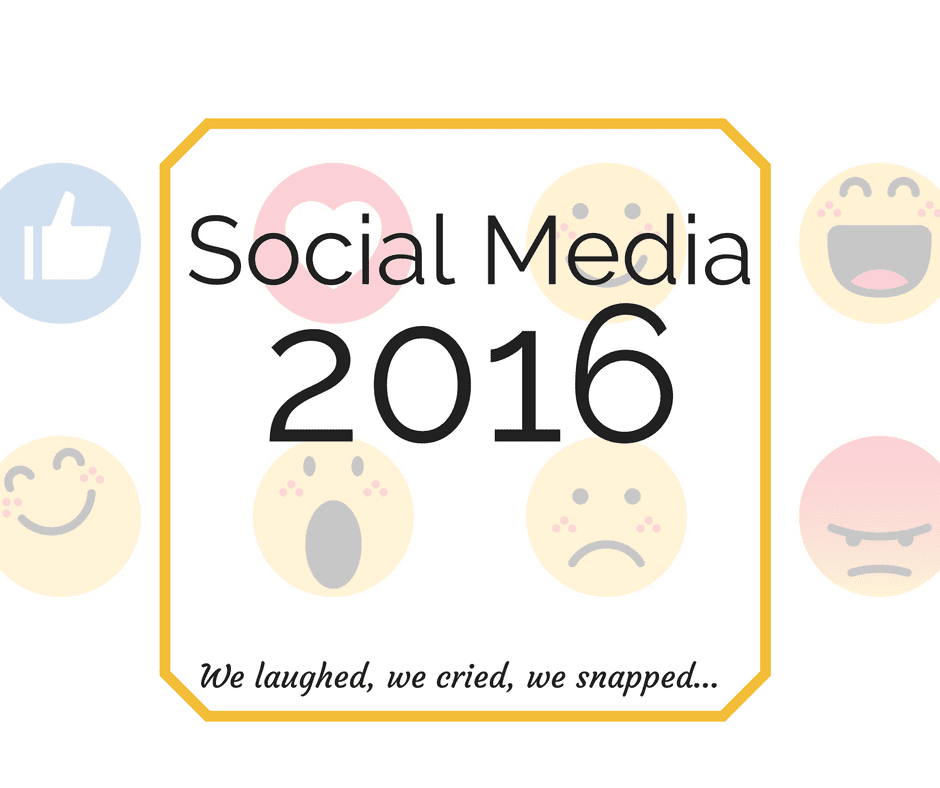Most of us can agree that 2016 can catch the next bus to “see ya” anytime now. (Prince, David-freaking-Bowie, SNAPE?! C’mon!) However you feel about this passing year, it was a doozy filled with any dank meme you could find to help you cope. The social media world was no different. From the giggling Chewbacca mom and Ken Bone to the #MannequinChallenge and everything in between, we saw some wacky things this year in our feeds. Here’s a snapshot.
Nostalgia Goes Mobile
If you happened to miss the first booming round of Pokémon in the late 90s/early 2000s, well then lucky you — 2016 delivered. Pokémon GO, an interactive, get-up-and-move app, debuted over the summer and broke records right from the very first Pokéball. It was the most downloaded app from the Apple store — ever. To date, the app has 500 million downloads, with 20 million active daily users (DMR Stats).
Like marketers tend to do, they jumped in on the trend. Your late-summer Facebook feed was likely splattered with pudgy creatures eluding red-and-white balls. Every restaurant, museum and hotel scurried to find a way to capitalize on the craze. The fever has worn a bit, but not before the app’s developer, Nianctic, captured $600 million to date.
Live in the Moment
Facebook Live is a 2015 baby, but a 2016 pop star. This year, Facebook made its live-streaming feature available to personal and business pages around the world, and, well, it was a game changer. Over half of all major media brands use Facebook Live weekly (if not daily) — and for good reason, too. Facebook Live videos receive 10 times more comments on average than traditional video uploaded to the platform (The Motley Fool).
Facebook has reacted to the popularity of live videos by recently updating Facebook Live with a scheduling option. This feature helps build an audience more quickly once a page goes live. It should also be noted that Facebook isn’t the only live option, Twitter’s Periscope also saw some gains in 2016, but as of September, it was up just 16 percent versus Facebook Live’s 47 percent increase (Socialbakers).
Snap Lasting Longer Than Its Snaps
Snap (formerly known as Snapchat) introduced us to filters: taco-face, monkeys in your hair, Harry Potter for a day! The face-altering feature caters to the narcissistic nature of its largest audience: tweens to 25-year-olds. The filters suck you in. (And those voice changers? Entertainment — for hours!) From there, you begin to explore the other functions, like one of the network’s most impactful features: Stories. Snap is not 2016 news; neither is Stories, which was introduced back in 2013. The real news is the big ole piece of the social-space pie that Snap took in 2016.
The selfie-loving platform’s success with Stories forced Instagram (or, more specifically, parent company Facebook, which finally couldn’t buy its way into something) to play catch-up. And just like that, “Snapchat reshaped the social media landscape … and has quietly become one of the world’s most innovative and influential consumer technology companies.” (The New York Times) Just how big was 2016 for Snap, Inc.? Well, the company just filed confidential documents for a potential stock offering that could value it at $30 billion (with a ‘B’!).
Unlike the fire hose of Twitter or the ad-clogged feed of Facebook, humans (rather than algorithms and filtering) drive Snap. Also dissimilar to its social peers, the platform — in an effort to protect its appeal — has guarded its audience behind a mighty filter from advertisers. Though the rumors are flying that the company will be coming down on its ad prices in 2017, an ad placement is currently somewhere between $450K and $700K per day (The Wall Street Journal).
The Civics of Social Media
We can’t really finish a blog about social media in 2016 without talking about the elephant (and donkey!) in the room. This year’s election cycle played out in all of its dragged-out, table-flipping glory right before our very eyes on social networks. It didn’t matter where you sat on the spectrum, your ilk had a voice in the form of secret Facebook groups, hashtags and fan pages. In fact, this year’s U.S. presidential election was the most discussed topic on Facebook, and videos related to the election were among the site’s most viewed — they made up two out of the top five Facebook Live videos for the year (Politico).
For better or worse, social media did help turn out the vote, as it has done in most recent election cycles. However, this year’s cycle seemed to blow up echo chambers and false influencers. One of the lessons learned out of the rogue-ness that social media often elevates is the prevalence of fake news. Facebook’s Mark Zuckerburg even released a statement saying the company is working to address the issue; Google also recently announced it is working to combat fake news in its search results.
And lastly, you know who else benefited from the election’s rampage on our social feeds? The alcohol industry!
Cheers to 2017!
